7 Best Grass Types for Oklahoma City
BY JANAE SOULES | MARCH 24TH, 2023 | LAWN CARE, OKLAHOMA, OKLAHOMA CITYIf you like to host BBQs for all the Sooners games, your grass needs to withstand the viewing party’s emotional roller coaster as you watch the score. Your turf also needs to handle OKC’s roller coaster weather. To get your yard ready for the games (and the changing seasons), we’ve compiled a list of the 7 best grass types for your Oklahoma City lawn.
Oklahoma City is in the transition zone, which means your yard can grow either warm or cool-season grasses. This list includes 4 warm-season grasses: bermudagrass, Zoysiagrass, buffalograss, and St. Augustinegrass. The 3 best cool-season grasses for OKC include tall fescue, Kentucky bluegrass, and perennial ryegrass.
Each home has different lawn needs and uses, so you’ll have to evaluate different things, such as foot traffic, amount of shade, and how much maintenance you want to perform on your lawn. Let’s take a closer look at each grass type.
In this article, we’ll talk about:
- Warm-Season vs. Cool-Season Grasses
- 7 Best Grass Types for Oklahoma City
- FAQ About Oklahoma City Grass Types
- Choosing Plant and Grass Varieties for Your Oklahoma City Landscape
Warm-Season vs. Cool-Season Grasses
Warm-season grass goes dormant in the winter if the outside temperature drops below 60 degrees Fahrenheit or the soil temperature drops below 55 degrees. When temperatures warm up through spring, summer, and early autumn, expect your warm-season grass to thrive.
Cool-season grass needs additional water in summer as it endures dormancy. Cool-season grasses green up in early spring, enter dormancy in summer, return to green in autumn, and enter winter dormancy when the soil temperatures drop below 45 degrees Fahrenheit.
7 Best Grass Types for Oklahoma City
OKC sits in the transition zone for grass growing, which means your lawn can grow either warm-season or cool-season grasses. Northern states typically grow cool-season lawns that prefer long winters and mild summers, while southern states grow warm-season grasses that thrive throughout the warm summers and mild winters.
Since Oklahoma is sandwiched in the middle (aka the transition zone) it experiences both extreme summers and winters. The question is, what time of year do you want your lawn to be its greenest? The following 4 warm-season grasses will grow best in summer, while the 3 remaining cool-season grasses will grow best in spring and autumn.
1. Bermudagrass
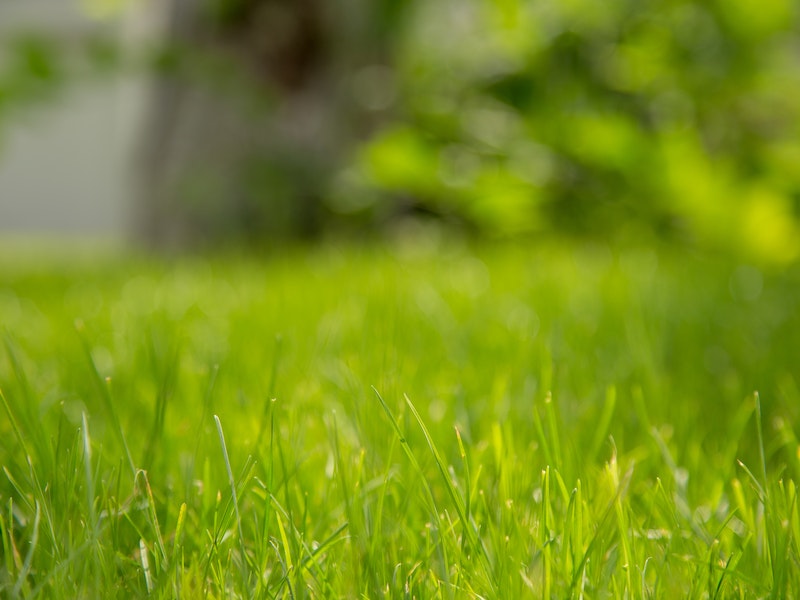
Photo Credit: Pexels
Thanks to its high foot traffic tolerance, kids and pets can run freely on bermudagrass for hours on end. It recovers quickly from damage, which is why you’ll often see bermudagrass on sports fields.
Bermudagrass checks many boxes: high drought tolerance, high foot traffic tolerance, high salt tolerance, and high heat tolerance.
But those upsides come with some downsides. Bermudagrass is high-maintenance and has low shade tolerance. So if your lawn receives shade, bermudagrass might struggle. If you’re looking for low-maintenance grass, bermudagrass might not be the optimal choice either. It grows fast, develops thatch, and can be invasive, so it requires lots of care and attention. Left unchecked, it can invade your flower beds.
Classification: Warm-season grass
Spreads by: Stolons and rhizomes
Shade Tolerance: Low – thrives in full sun.
Drought Tolerance: High
Foot Traffic Tolerance: High
Maintenance Needs: Fertilize once a year according to soil test results. Susceptible to thatch build-up – dethatch when thatch layer is more than ½ inch.
Mowing Height: Set the mowing height between 0.5 and 1.5 inches for hybrid bermudagrass cultivars. Mow common bermudagrass down to 1.5 to 2.5 inches.
Potential for Disease: Good resistance to disease, although diseases are common; low resistance to insects
Soil pH: 6-6.5
Soil type: Tolerates most soil types
Other Notes: Good tolerance to salt
2. Zoysiagrass
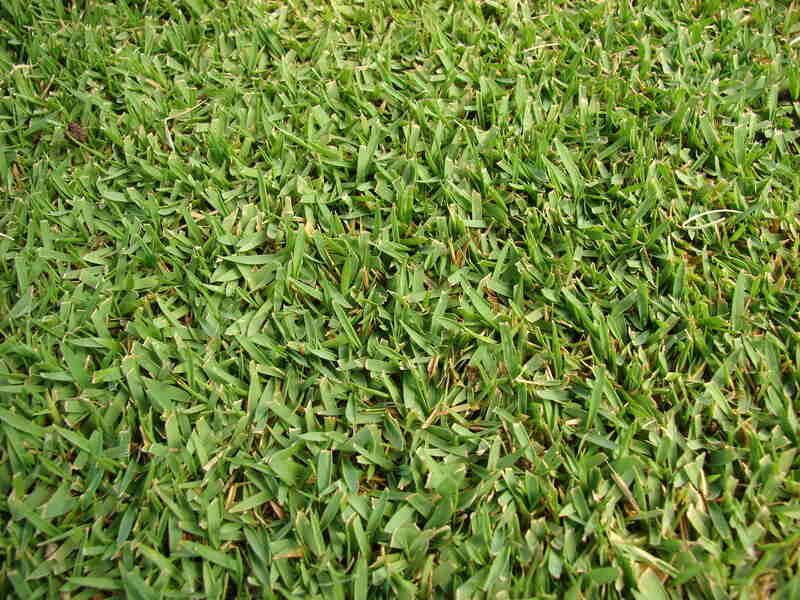
Photo Credit: Forest & Kim Starr / Wikimedia Commons / CC BY 3.0
Weeds are not generally a problem with Zoysiagrass, thanks to its dense growing habit. However, its thick growth makes the turf more susceptible to pet urine damage than other grass types. Why? Because the urine won’t drain well. Bermudagrass and St. Augustinegrass aren’t nearly as thick as Zoysiagrass, allowing the pet urine to drain through easier, leading to less damage.
If we compare Zoysiagrass to bermudagrass, you’ll notice that both grass types have a high foot traffic tolerance. However, some homeowners might prefer bermudagrass over Zoysiagrass because bermudagrass recovers faster. On the other hand, Zoysiagrass is more shade tolerant than bermudagrass, so you’ll need to consider which strength takes priority.
Zoysiagrass is a drought-tolerant and salt-tolerant grass.
Classification: Warm-season grass
Spreads by: Stolons and rhizomes
Shade Tolerance: Moderate
Drought Tolerance: Moderate
Foot Traffic Tolerance: High but recovers slowly from damage.
Maintenance Needs: Low to moderate nitrogen requirement; moderate mowing frequency
Mowing Height: Set mowing height between 1 to 2 inches.
Potential for Disease: Not prone to disease and insects; good disease tolerance overall
Soil pH: 6-6.5
Soil type: Well-draining, some cultivars more tolerant of a wide range of soils than others
Other Notes: Moderately salt tolerant; cut with sharp mower blade; mow taller if the grass is in partial shade
3. Buffalograss
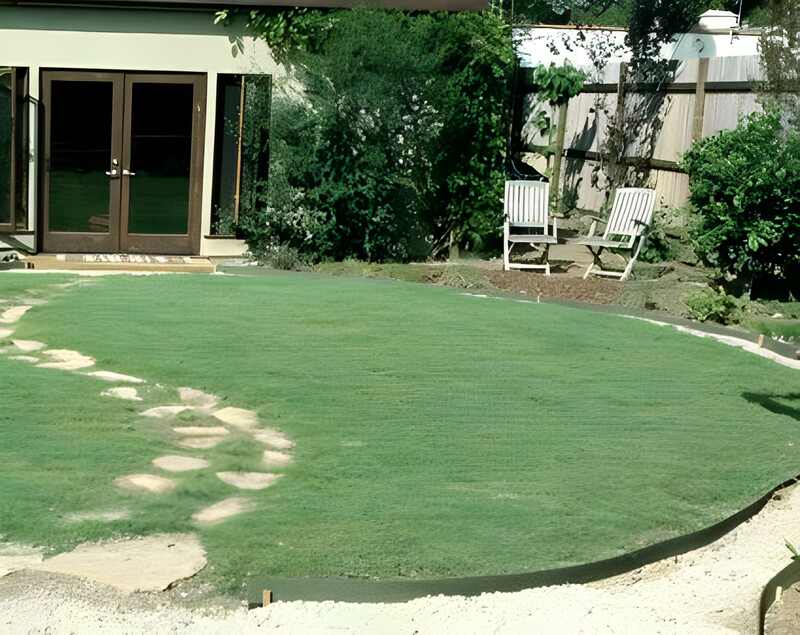
Photo Credit: Susan Harris / Flickr / CC BY 2.0
Buffalograss is a warm-season, low-maintenance, blue-green grass. Once it’s established, you won’t have to frequently mow, fertilize, or water your buffalograss lawn. Lawn diseases and insects aren’t generally a problem in buffalograss, which means less work on your end. However, buffalograss’ open growth habit can make weeds a never-ending battle.
Although buffalograss is soft to walk on barefoot, don’t let the foot traffic get too high on it – Buffalograss has a low foot traffic tolerance. It might not recover well after your Sooners-themed BBQ.
Classification: Warm-season grass
Spreads by: Stolons
Shade tolerance: Low
Drought tolerance: High
Foot traffic tolerance: Low
Maintenance needs: Low fertilizer and mowing needs. Develops thatch and requires weed control.
Mowing height: Set the mowing height between 2 and 3 inches.
Potential for disease: Good tolerance against diseases and insects
Soil pH: 6.5-7.5
Soil type: Native clay soils, not sandy soils
Other notes: Overwatering could cause invasive weeds
4. St. Augustinegrass
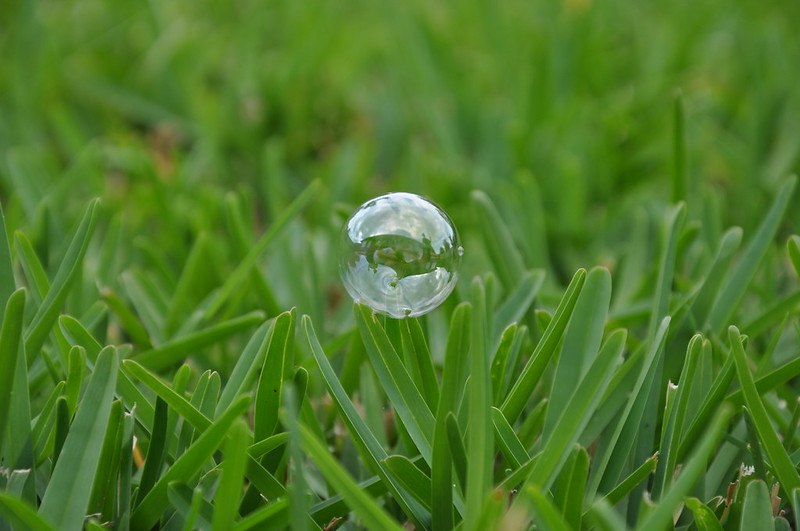
Photo Credit: Jay Morgan / Flickr / CC BY-ND 2.0
St. Augustinegrass is a rich green-colored, high-maintenance, warm-season grass. Homeowners will have to perform many maintenance tasks during the active growing season. These tasks include fertilizing regularly, dethatching, aerating, and inspecting for lawn diseases and pests.
Unlike bermudagrass, St. Augustinegrass can tolerate shade. It’s the most shade-tolerant warm-season grass, which makes it an excellent choice if your lawn receives shade.
If your family spends time in your saltwater pool for exercise instead of running around on the grass, St. Augustinegrass may be a good fit–– it has a low foot traffic tolerance but can tolerate salt.
Classification: Warm-season grass
Spreads by: Stolons
Shade tolerance: Moderate. It is the most shade-tolerant warm-season grass.
Drought tolerance: Moderate to High
Foot traffic tolerance: Low
Maintenance needs: Needs frequent mowing due to fast growth rate; develops thatch easily; needs regular fertilization
Mowing height: Set the mowing height between 3.5 and 4 inches.
Potential for disease: Moderate to high
Soil pH: 6-7.5
Soil type: Tolerates many soil types; prefers moderately fertile and moist (not waterlogged) soils; doesn’t tolerate soil compaction
Other notes: Vulnerable to lawn pests such as chinch bugs, white grubs, and mole crickets.
5. Tall Fescue
Tall fescue is a great transition zone grass because its deep roots help with drought tolerance (it will need water during the summer with periods of little rainfall, though). Among other cool-season grasses, tall fescue has the highest heat tolerance. It’s also low maintenance and doesn’t need regular fertilization compared to other cool-season grasses, like Kentucky bluegrass.
However, OKC’s humidity could increase the possibility of lawn pests with tall fescue. If pests damage your tall fescue lawn, you’ll need to overseed it because this turf doesn’t repair itself well.
Classification: Cool-season grass
Spreads by: Produces short rhizomes but has a bunch-type growth habit
Shade tolerance: Moderate
Drought tolerance: Moderate to High
Foot traffic tolerance: Moderate
Maintenance needs: Frequent mowing. Does not produce significant thatch.
Mowing height: Set mowing height to 2 inches when grass reaches 3 inches tall.
Potential for disease: Tolerant of most diseases when properly maintained.
Soil pH: 5.5-6.5
Soil type: Adapted to a wide range of soil conditions but prefers fertile clay soils with good drainage.
Other notes: Aerate in the fall if your soil gets compacted
6. Kentucky Bluegrass
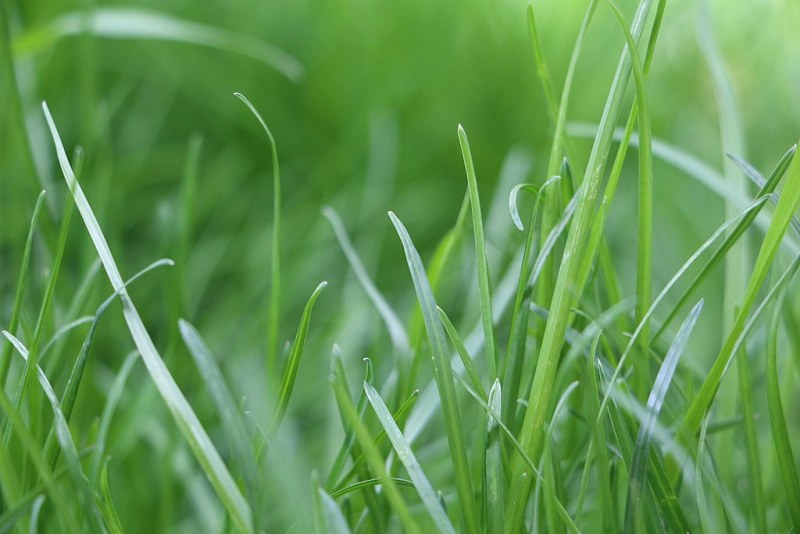
Photo Credit: Pilot138-17 / Wikimedia Commons / CC BY-SA 4.0
Kentucky bluegrass is a high-maintenance cool-season grass that needs full sun. It’s considered high-maintenance because it needs to be mowed, fertilized frequently, dethatched every one to two years, and monitored for lawn diseases.
Kentucky bluegrass is soft to walk on and has a deep green color. If it gets damaged from your cornhole boards always being in the same spot, rest assured the rhizomes in Kentucky bluegrass will self-repair (unlike tall fescue).
Classification: Cool-season grass
Spreads by: Rhizomes
Shade tolerance: Low
Drought tolerance: Moderate
Foot traffic tolerance: Moderate
Maintenance needs: Moderate mowing frequency and high fertilization needs.
Mowing height: Set mowing height between 2.5 and 3.5 inches.
Potential for disease: Moderate to high; prone to several diseases, such as dollar spot, leaf spot, necrotic ring spot, summer patch, and stripe smut.
Soil pH: 6-7.5
Soil type: Performs best in well-drained, heavy soils with high fertility.
Other notes: Produces a dense lawn under ideal conditions; many of these traits (shade tolerance, drought resistance, etc.) vary widely by cultivar, with newer cultivars generally being hardier, more resistant to disease, etc.; mow taller in summer; most often mixed with other species in home lawns, such as tall fescue.
7. Perennial Ryegrass
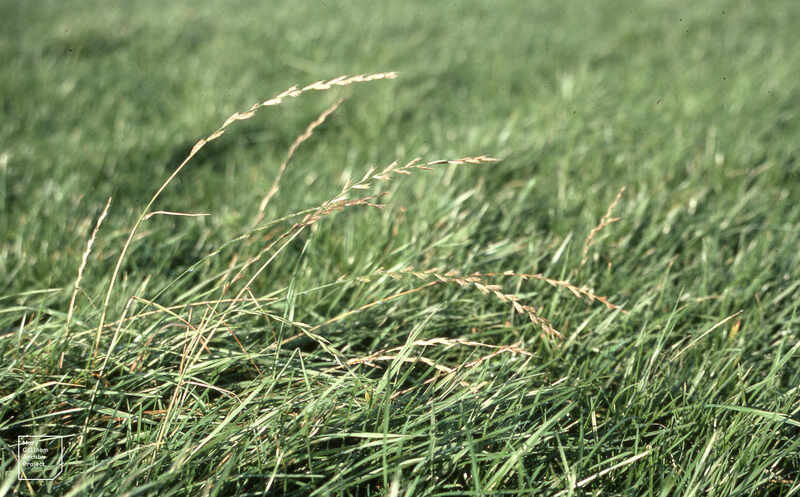
Photo Credit: Dr Mary Gillham Archive Project / Flickr / CC BY 2.0
Perennial ryegrass is a cool-season, fast germinating, medium to dark green-colored grass. It is most often used in The Big Friendly to overseed warm-season lawns, such as bermudagrass. Overseeding warm-season lawns with cool-season grass can extend the lawn’s green period in winter.
Perennial ryegrass cultivars such as Diplomat, Citation, Palmer, Prelude, Ranger, and Repell perform well in Oklahoma City conditions.
Classification: Cool-season grass
Spreads by: Has a bunch-type growth habit
Shade tolerance: Low
Drought tolerance: Low
Foot traffic tolerance: High
Maintenance needs: Moderate mowing and fertilization requirements. Thatch is not significant.
Mowing height: Set mowing height to 1.5 to 2.5 inches
Potential for disease: High. Common diseases include gray leaf spot, red thread, and leaf spot/melting-out.
Soil pH: Can grow in soils with a pH between 5 and 8, but prefers between 6 and 7.
Soil type: Prefers good drainage and fertility, but can tolerate some poor drainage.
Other notes: Develops less thatch than other cool-season grasses.
FAQ About Oklahoma City Grass Types
The best time to plant grass seed in Oklahoma City depends on if you choose warm-season or cool-season grass. Warm-season grasses should be planted between late spring and early summer. Cool-season grasses should be planted between late August to early October.
If you want to avoid pulling weeds and spraying herbicides, consider Zoysiagrass. Its thick growth habit helps choke out weeds.
St. Augustinegrass is the best warm-season grass type for a shaded lawn. For cool-season grass, tall fescue is the best choice from this list.
Choosing Plant and Grass Varieties for Your Oklahoma City Landscape
You’ve decided on the grass type that best fits the yard’s foot traffic, shaded and sunny areas, and your maintenance needs (how much do you want to be sweating doing maintenance in the hot summer sun?). But a nice lawn is only one aspect of your OKC landscape – remember to adorn the lawn with OKC’s best native plants, too.
Want more time to visit the Oklahoma City Zoo instead of maintaining the lawn? Contact an Oklahoma City lawn care professional to help take over your lawn mowing, edging, and trimming.